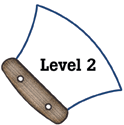
Alaska Science
Key Element A14c
A student who meets the content standard should understand that a small change in a portion of an environment may affect the entire environment (Interdependence).
 |
Alaska Science A student who meets the content standard should understand that a small change in a portion of an environment may affect the entire environment (Interdependence). |
|
Performance Standard Level 2, Ages 8–10
|
|
|
|
Sample Assessment Ideas
|
|
|
Expanded Sample Assessment Idea
|
|
Procedure Students will:
Reflection and Revision
|
Levels of Performance |
||
|
Stage 4 |
Student work is complete, and shows evidence of logical reasoning. Student prepares a detailed report that includes a description of when and where the birds migrate, underlying factors responsible for the migration, and the time of migration. | ||
|
Stage 3
|
Student work shows evidence of logical reasoning but may contain minor errors or omissions. Student prepares a report that includes: a description of when and where the birds migrate, factors that influence migration, and may include the time of migration. | ||
|
Stage 2
|
Student prepares a report about a migratory bird, but it may be incomplete, or contain errors of science fact and reasoning. | ||
|
Stage 1
|
Student report is largely incomplete, incorrect, shows little evidence of understanding, and may contain major misconceptions. | ||
Standards Cross-References
|
||
|
National Science Education Standards All organisms cause changes in the environment where they live. Some of these changes are detrimental to the organism or other organisms, whereas others are beneficial. (Page 129) Some environmental changes occur slowly, and others occur rapidly. Students should understand the different consequences of changing environments in small increments over long periods as compared with changing environments in large increments over short periods of time. (Page 140) An organism’s behavior evolves through adaptation to its environment. How a species lives, obtains food, reproduces, and responds to danger are based in the species’ evolutionary history. (Page 157) The number of organisms an ecosystem can support depends on the resources available and abiotic factors, such as quantity of light and water, range of temperatures, and soil composition. Given adequate biotic and abiotic resources and no disease or predators, populations (including humans) increase at rapid rates. Lack of resources and other factors, such as predation and climate, limit the growth of populations in specific niches in the ecosystem. (Page 158) |
Benchmarks Changes in an organism’s habitat are sometimes beneficial to it and sometimes harmful. (Page 116) |
|
Table of Contents | Return to Alaska Native Knowledge Network